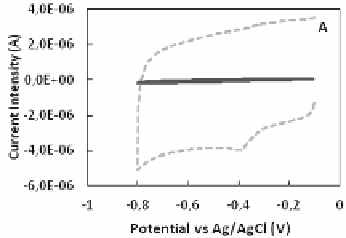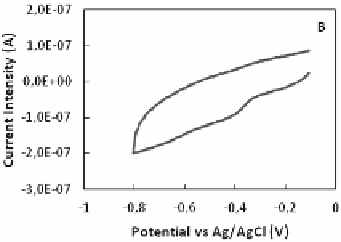Biomedical Engineering Reference
In-Depth Information
3
Results
3.1
Effect of the Carbon Ink on the Bioelectrode Response
Preliminary experiments were carried out in order to check if the chemicals (organic
solvents) and the thermal treatment (curing) required for printing the working elec-
trode component in CPSPEs were compatible with nitrite reductase activity. In this
regard, three different PG electrodes were modified with i) ccNiR only, ii) ccNiR
mixed with carbon ink diluted in acetone and iii) the same as (ii) but with an extra
curing step at 60
°
C.
Non-catalytic Response.
Regardless of the composition of the electrode
coating, in
the absence of the enzyme substrate the CVs displayed a small and broad cathodic
wave at
ca
. -0.380 V
vs
Ag/AgCl, as illustrated in Fig. 2A.
Fig. 2.
CVs of ccNiR coated PG electrodes, traced at 20 mV/s, in 0.1 M KCl, 0.05 M Tris-HCl,
pH 7.5. (A) (
- - -
) enzyme mixed with carbon ink (diluted in acetone); (
⎯
) enzyme casted di-
rectly onto a bare electrode, as zoomed in (B). The modified electrodes were dried at room
temperature (≈ 22°C).
This non-catalytic signal can be assigned to the redox co-factors of ccNiR, as pre-
viously seen
in bare PGEs and carbon nanotubes modified electrodes [14,18]. Due to
the consequent enlargement of the electroactive area, in the presence of the carbon ink
both Faradaic and capacitive currents increased over 20 times when compared to ones
obtained with bare electrodes (Fig. 2B).
Response to Nitrite - Temperature and Solvent Effects.
In the presence of the en-
zyme substrate, the CVs exhibited a sigmoid shape (Fig. 3) reflecting the direct
charge transfer between the electrode surface and ccNiR and the subsequent catalytic
reduction of nitrite into ammonium.
In general, the plots catalytic current (I
cat
)
vs
nitrite concentration (Fig. 4) could be
fitted to a hyperbolic equation denoting a Michaelis-Menten profile (eq. 2) i.e., at high
nitrite concentrations the current response deviated from linearity and approached a
constant value, reflecting the maximum rate of the enzymatic reaction under nitrite
saturating conditions (I
max
). Interestingly, this value has increased about three times in
the presence of the conductive ink, which should be related with the surface area
increase (Fig. 4).



Search WWH ::

Custom Search